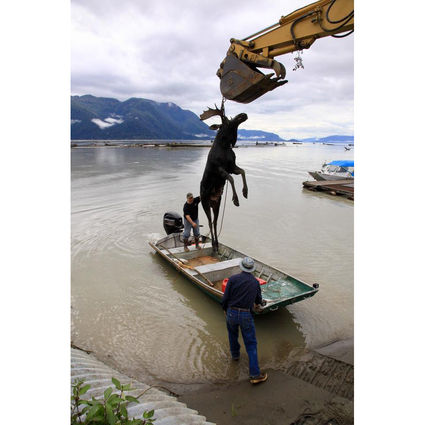Moose season starts off ahead of average

Submitted Photo
Jason Nyman and Richard Kaer help shift a moose from the Stikine River's natural refrigerator near Farm Island on Sept. 17, assisted by Gary Allen in the backhoe. The animal was shot by Clay Hammer further upriver, after the party had about given up on hunting moose and moved on to trout fishing. Hammer said the moose was only the second he had successfully hunted on the river in nearly three decades, and after boning out the meat it yielded 500 pounds. "It was a good day." he said.
Opening up on September 15, the local moose season is off to a positive start.
As of last Friday, hunters in the Wrangell, Petersburg and Kake area had so far logged in 32 legal moose, 31 of which were taken within the first week, ending September 21. At first looking a little slim, the total had bumped up in the succeeding days as hunters continued to log moose they had harvested over the period. Under regulations, they have five days after the kill to check in a harvested moose.
"Actually, it looks pretty good," said Rich Lowell, area wildlife biologist for the Petersburg office of Alaska Department of Fish and Game.
Looking at previous years, he estimated the week-one average for the unit has been 24 since 2009, when antler restrictions were loosened. Before the bump, by the end of the first week last Wednesday the total seemed to be running just shy of that.
Antler regulations have been updated again this season, with the definition of spike-fork antlers clarified by the Board of Game earlier this year at the request of the local game advisory committee. Lowell said the new definitions have helped one Petersburg-area hunter keep their kill so far, but that for the most part the change will likely not have too much impact on the number of illegal moose that are shot.
The brow tine restrictions are intended to protect the middle-aged segment of the bull population for breeding purposes. So far, the number of bulls not meeting regulation has been pretty low, with only two shot during the first week's harvest. Last year a problematic proportion of illegal moose early on in the season came close to having it end early, so the comparatively smaller number this year is welcome.
"That can change really quickly," Lowell added.
The reported harvest to date is only slightly less than last year at this time, when hunters harvested a total of 34 moose during the first week of the season. Last year's harvest in total had been the second highest on record for the area, which Lowell attributed to a strong showing around the Stikine River. The moose population up the Stikine is healthy following a mild winter, though
that does not necessarily ensure success on the part of local hunters.
The greatest number of bulls taken so far has been from the Kupreanof Island area, with 10 found there. Six moose have been taken by hunters on the Stikine River, and the same from Thomas Bay. Four were killed on Mitkof Island, two at Farragut Bay, and one on Virginia Lake.
Unusually, two were also harvested on Wrangell Island itself. For the whole season last year, only one had been taken there.
All hunting permit holders are reminded to complete and submit a season report, even if they did not actually participate in hunting. Reports can be filed with the nearest ADFG department offices in Wrangell, Petersburg, Douglas, Kake or Sitka, or online at http://hunt.alaska.gov. Failure to do so can result in ineligibility for permits next year.




Reader Comments(0)